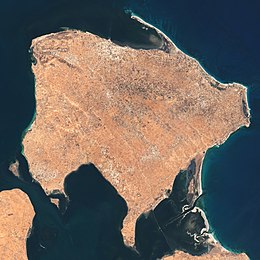
Back Cherba AN جربة Arabic جربه ARZ Cerba Azerbaijani Джерба (утрау) Bashkir Джэрба Byelorussian Джерба Bulgarian Gerba Catalan Île de Jerba CEB Džerba Czech
This article has multiple issues. Please help improve it or discuss these issues on the talk page. (Learn how and when to remove these messages)
|
 Satellite photograph of Djerba | |
| Geography | |
| Location | Gulf of Gabès |
| Area | 514 km2 (198 sq mi) |
| Administration | |
| Governorate | Medenine |
| Largest settlement | Houmt Souk (pop. 75,904) |
| Demographics | |
| Demonym | Djerbian Jerbi |
| Population | 182,911 (2022 census) |
| Pop. density | 309/km2 (800/sq mi) |
| Ethnic groups | Tunisians (Arabs, Turks, Berbers, Jews and Black Tunisians) |
| Official name | Djerba: Testimony to a settlement pattern in an island territory |
| Type | Cultural |
| Criteria | v |
| Designated | 2023 (45th session) |
| Reference no. | 1640[1] |
Djerba (/ˈdʒɜːrbə, ˈdʒɛərbə/; Arabic: جربة, romanized: Jirba, IPA: [ˈʒɪrbæ] ⓘ; Italian: Meninge, Girba), also transliterated as Jerba[2] or Jarbah,[3] is a Tunisian island and the largest island of North Africa at 514 square kilometers (198 sq mi), in the Gulf of Gabès,[2] off the coast of Tunisia. Administratively, it is part of Medenine Governorate. The island had a population of 139,544 at the 2004 census, which rose to 163,726 at the 2014 census. Citing its long and unique history, Tunisia has sought UNESCO World Heritage status protections for the island,[4] and, in 2023, Djerba was officially designated a World Heritage Site.[5]
- ^ "Djerba: Testimony to a settlement pattern in an island territory". UNESCO World Heritage Centre. Retrieved 24 September 2023.
- ^ a b Chisholm, Hugh, ed. (1911). . Encyclopædia Britannica. Vol. 15 (11th ed.). Cambridge University Press. p. 322.
- ^ "Converter: Arabic, ar, 'alyrbiah', العربية". www.uconv.com. Retrieved 10 May 2023.
- ^ Center, UNESCO World Heritage. "Regional Workshop on the World Heritage Nomination Process". UNESCO World Heritage Center. Retrieved 6 December 2018.
- ^ Centre, UNESCO World Heritage. "Djerba: Testimony to a settlement pattern in an island territory". UNESCO World Heritage Centre. Retrieved 24 September 2023.
